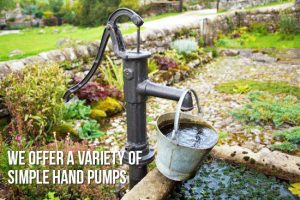The days of using a bucket and rope to retrieve water from a well are long gone. Pump technology has put an end to this primitive method.
Using centrifugal force, a well pump shoots water from its underground reservoir up to your home for use. The depth at which your well sits will determine which style of well pump you’ll need.
What Type of Well Pump Do I Need in Alaska?
Luckily, choosing the right type of well pump is easy, and it mostly depends on the size of your well. You will have a few other preferences to choose from if you’re installing a new one, though usually, homes built with a well-water system already have an existing well pump in place and you’d simply need to replace it with the same type if you experience any issues.
One of the biggest complaints homeowners have with their pumps in the Mat-Su Valley is low or undesirable water pressure. But, if you pair your well pump system with a variable speed pump, you can increase water pressure to all the fixtures in your home easily and quickly, regardless of the type of well pump you are using.
How to Size a Well Pump
The most important factors to consider when choosing a well pump (besides a submersible vs non-submersible pump) are gallons per minute (GPM) rate and PSI ratings.
The pump needs to be powerful enough to over come the depth of the well, the plumbing of the house and the fixtures in the house, while still being sized correctly for the well. Sometimes well production doesn’t meet home plumbing needs and other or alternative solutions need to be explored. Wheaton can help explore those alternatives.
Shallow Well Pumps
Shallow well pumps are found in applications where the well is less than 25′ deep and operate as above-ground well pumps. This style of pump is not submersible and is placed outside the well in a well housing.
A feature you should look for is overload protection, which prevents motor burnout. The best shallow well pump systems are accompanied by a tank or a booster to increase PSI, which provides constant water pressure to your home. If pump size is a restriction due to your well housing, choose a pump with a booster as this will take up less space.
Deep Well Pumps
Deep well pumps can be used in wells as deep as 90 – 300′ below ground. Unlike shallow well pumps, deep well pumps are submerged inside your well. Considering these pumps can be several hundred feet below ground, a 3-wire model makes maintenance easier.
This is because the starter controls are above ground, wired to the pump. a 2-wire model is easier to install, but should the pump fail, you’ll need to bring it up to ground-level to fix it.
Convertible Jet Pumps
Convertible jet pumps can operate between 0 – 25′ with a shallow jet well nozzle or between 25 – 90′ with the proper deep well jet nozzle. These pumps are not submersible and are situated in a well housing. These pumps are popular with people who have a fluctuating water table.
The jet portion of the pump, otherwise known as an ejector, has the primary function of increasing pressure to help draw water from a deeper depth. The pump works by creating a vacuum in the suction pipe and relies on atmospheric pressure to force the water from the well to the pump. Drawing that water vertically is measured and referred to as Suction Head (SH) or Total Lift Head (TLH).


